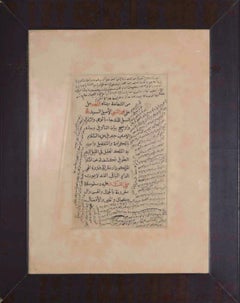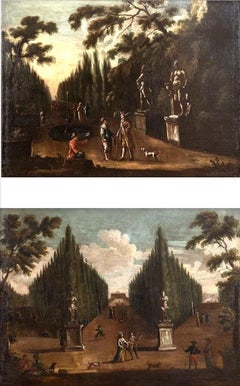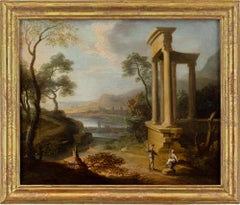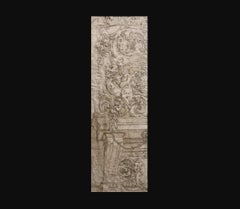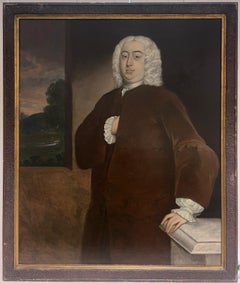18th Century Art
to
704
3,314
1,071
390
248
300
Overall Width
to
Overall Height
to
7,555
20,992
156,667
235,203
1,865
2,214
4,765
6,460
5,817
13,094
19,567
25,074
17,312
13,353
5,324
2,236
1,126
40
18
9
3
1
2,719
2,120
369
3,122
1,555
1,061
913
863
691
603
436
404
366
309
272
263
188
173
158
142
123
120
116
3,098
1,242
911
786
474
159
127
87
82
74
1,215
3,016
3,343
836
Period: 18th Century
Family gathering Winter Fuel in a Landscape - British Old Master oil painting
Located in Hagley, England
This charming large British Old Master pastoral oil painting is by noted artist Francis Wheatley. It was painted in 1797 and depicts five figures, a family and a dog in a woodland s...
Category
Old Masters 18th Century Art
Materials
Oil
Salla Alla Muhammad An-Nabi - Arabic Calligraphy
Located in Roma, IT
Salla Alla Muhammad An-Nabi - Arabic Calligraphy is a beautiful and precious manuscript with Islamic Sacred Verses in an ancient calligraphy style.
One page, one-sided, in Arabic, ...
Category
18th Century Art
Materials
Ink
Pair of Italian 18' century Paintings with Gardens
Located in Rome, IT
Pair of Italian 18' century paintings , oil on canvas with Venetian Palace gardens , antiques sculptures and various figures .
Measurements with f...
Category
Old Masters 18th Century Art
Materials
Oil
Early 18th-Century French School, Classical Landscape With Ruins & Figures
Located in Cheltenham, GB
This splendid early 18th-century classical landscape painting depicts an idyllic coastal view with architectural ruins and figures.
Inspired by the romanticised visions of Claude Lo...
Category
Baroque 18th Century Art
Materials
Oil, Canvas
Architectural Stucco Design, Pen and Ink Drawing, Signed, 18th Century Italian
Located in London, GB
Pen and brown ink and brown and grey washes on paper
Signed top middle
Image size: 10 x 3 3/4 inches (25.5 x 8 cm)
The sketch is a useful example of Bigari's work in the late-Baroqu...
Category
18th Century Art
Materials
Paper, Ink, Pen
Fine 18th Century English Portrait of Aristocratic Gentleman Huge Oil Painting
Located in Cirencester, Gloucestershire
Portrait of an Aristocratic English Gentleman
circle of Thomas Hudson (British (1701-1779)
oil on canvas, framed
framed: 53.5 x 45 inches
painting: 45 x 40 inches
provenance: private...
Category
Old Masters 18th Century Art
Materials
Oil
$2,881 Sale Price
30% Off
Group of Four Mezzotint Hunting Plates.
Located in London, GB
4 mezzotint engravings by and after Ridinger (c.55 x 43 cm.) with margins on all sides.
[Published: Augsburg, 1750].
A fine group showing 2 male and 2 female hunters along with the ...
Category
Naturalistic 18th Century Art
Materials
Handmade Paper, Engraving, Mezzotint
Portrait of a Young Boy Carrying a Fruit Basket, 18th Century Oil on Canvas
By Thomas Beach
Located in London, GB
Oil on canvas
Image size: 30 x 25 inches (76 x 63.5 cm)
Contemporary hand-carved frame
This is a charming 18th century portrait of a young boy, sporting a golden child's two-piece w...
Category
English School 18th Century Art
Materials
Canvas, Oil
Letter B - Etching by Luigi Vanvitelli - 18th Century
Located in Roma, IT
Letter B is an Etching realized by Luigi Vanvitelli.
The etching belongs to the print suite “Antiquities of Herculaneum Exposed” (original title: “Le Antichità di Ercolano Esposte”)...
Category
Old Masters 18th Century Art
Materials
Etching
Ancient Roman Statue - Original Etching by Pietro Campana - 18th Century
Located in Roma, IT
Ancient Roman Statue, from the series "Antiquities of Herculaneum", is an original etching on paper realized by P. Campana in the 18th century.
Signed on the plate, on the lower rig...
Category
Modern 18th Century Art
Materials
Etching
Leopards and Mole Engraving
Located in New York, NY
Original engraving with later hand-coloring from "Locupletissimi rerum naturalium thesauri accurata descriptio, et iconibus artificiossimis expressio, per universam physices historia...
Category
18th Century Art
Materials
Laid Paper
$849 Sale Price
29% Off
18th Century English Double Handle Footman
Located in Beachwood, OH
English Double Handle Footman, 18th Century
Brass
12 x 18 x 17 inches
Category
18th Century Art
Materials
Brass
18Th Century Botanical Engraving
Located in Lake Worth Beach, FL
Rare Botanical Hand Colored Engraving about 1737-1745
Beautifully framed French hand painted mat, in gold leaf frame each print measure 9.5x14.5 with the frame 23.5hx18.5x1
Johann ...
Category
Old Masters 18th Century Art
Materials
Engraving
18th Century French Orientalist Portrait of Arab Man in Turban, oil painting
Located in Cirencester, Gloucestershire
Portrait of Arab Man in Turban
French artist, 18th century
oil on canvas, framed
Framed: 21 x 16.5 inches
Canvas : 18.5 x 14 inches
Provenance: private collection, France
Condition: ...
Category
Old Masters 18th Century Art
Materials
Oil, Canvas
$1,777 Sale Price
30% Off
A Pair of Italian Carved Gilt Wood Antique Frames circa 1755
Located in Jacksonville, FL
A Pair of Italian Carved Gilt Wood Antique Frames , Mirror not included. Circa 1755.
Frame Size: Width: 20.25″ X Height: 23.75″
Thickness: 4″
Pict...
Category
18th Century Art
Materials
Wood
Flemish Oak Statue of a Putto
Located in Los Angeles, CA
Hand-carved, oak statue of a putto holding a flowing tapestry and a shield mounted on a custom, Lucite base.
Category
18th Century Art
Materials
Oak, Lucite
Landscape with figures - Original Oil Paint On Canvas - 18th Century
Located in Roma, IT
Landscape with figures is an original oil on canvas realized in the XVIII Century by a Venetian School Master.
Original oil painting on Canvas.
The painting represents a beautiful...
Category
Modern 18th Century Art
Materials
Canvas, Oil
Attrib. Johann Tischbein (1751-1829)- 18th Century Pastel, Maria Luisa of Parma
Located in Corsham, GB
A romantic late 18th-century pastel portrait, attributed to the German portraitist Johann Heinrich Wilhelm Tischbein (1751-1829). Exquisitely presented in its original giltwood frame...
Category
18th Century Art
Materials
Pastel
The Resurrection
Located in Middletown, NY
A rare and beautiful 18th century bible illustration by a female artist.
Engraving on cream laid paper with a "V" shaped watermark, 8 x 4 5/8 inch...
Category
Italian School 18th Century Art
Materials
Laid Paper, Engraving
Paull Sandby, R.A. Ink & Wash on Paper of a Chair
By Paul Sandby
Located in Bristol, CT
Art Sz: 4 1/4"H x 3 1/2"W
Frame Sz: 8"H x 7"W
Paul Sandby RA (1731 – 7 November 1809) was an English map-maker turned landscape painter in watercolours, who, along with his older b...
Category
18th Century Art
Materials
Ink, Pen
View of the Castle of Versailles - Etching - 1748
Located in Roma, IT
Etching on paper realized in 1748.
Very good condition except for some minor foxing.
Includes a wooden frame cm. 27.5x41.5
Category
Modern 18th Century Art
Materials
Etching
Marine orageuse, dans le goût de Joseph Vernet (1714-1789)
By Claude-Joseph Vernet
Located in GOUVIEUX, FR
dans legoût de Joseph Vernet (1714-1789) Huile sur sur panneau Dim sans cadre 28/21 cm Dim avec cadre 38/31 cm Ecole française Cadre doré Cette saisissante scène de tempête rend homm...
Category
French School 18th Century Art
Materials
Oil
A Promenade to a Rout on a fair Evening
By Isaac Cruikshank
Located in Middletown, NY
London: Allen & West, 1797.
Engraving with hand coloring in watercolor on cream wove paper, 8 1/8 x 10 5/8 inches (213 x 270 mm), wide margins. Scattered toning, mat tone, and dog-e...
Category
English School 18th Century Art
Materials
Watercolor, Handmade Paper, Engraving
Sketch of Three Figures
Located in London, GB
Benjamin Robert Haydon
1786 - 1846
Sketch of Three Figures
Pen and ink on paper,
Image size: 9 3/4 x 7 3/4 inches (25 x 20 cm)
Acid Free mount, original frame
Provenance
Private Col...
Category
English School 18th Century Art
Materials
Paper, Ink, Pen
1800's French Neo Classical Old Master Chalk Drawing Roman Figures Court Scene
Located in Cirencester, Gloucestershire
The Roman Court
French School, circa 1780-1820 period
pencil/charcoal/white chalk drawing on artist paper
stamped with a name (either a collector or the artist)
size: 18 x 24 inches
...
Category
Old Masters 18th Century Art
Materials
Chalk, Charcoal, Pencil
$1,536 Sale Price
30% Off
Hand Coloured 18th Century Copper engraving from "Small Riding School" No 32
Located in Cotignac, FR
Mid 18th century hand coloured copper plate engraving of an equestrian subject by Johann Elias Ridinger. Initial signed 'in the plate' bottom right. Presented in a fine gilt wood fra...
Category
Rococo 18th Century Art
Materials
Watercolor, Ink
A Riverside Conversation
Located in London, GB
British School
Oil on Canvas
Image Size: 31 inches x 25 3/4 inches (79 x 65.5 cm)
Original gilt frame
Gathered along a riverside are two fishermen turned in conversation, one of who...
Category
English School 18th Century Art
Materials
Oil, Canvas
"Eucharistic miracle of the mule and the heretic before Saint Anthony of Padua"
Located in Edinburgh, GB
Francesco Belotto (1721–1780)
"Eucharistic Miracle of the Mule and the Heretic Before Saint Anthony of Padua"
Framed: 82 x 170 cm
Flat: 76 x 161 cm
Medium: Oil on canvas
This dramat...
Category
Realist 18th Century Art
Materials
Canvas, Oil
Veduta in Prospettiva della gran Fontana dell'Acqua Vergine detta di Trevi
Located in New York, NY
Etching, 1773.
From the Vedute di Roma.
Framed dimensions 25.5 x 34.5 inches.
Category
Old Masters 18th Century Art
Materials
Etching
Painting flemish school 18th century oil on panel wood - Interior tavern
Located in PARIS, FR
Nordic school of the 18th century Oil on panel on wood 27 cm x 33 cm (42 x 51 cm with the frame) Old frame in carved and gilded wood Good condition even ...
Category
Dutch School 18th Century Art
Materials
Oil
Portrait Of A Lady Holding A Flue, 18th Century French School
Located in Blackwater, GB
Portrait Of A Lady Holding A Flue, 18th Century
French School
Large 18th century French School portrait of a lady holding a flute, oil on canvas. Magnificent and unusual portrait ...
Category
18th Century Art
Materials
Canvas, Oil
Still life painting of fruit in a basket
Located in London, GB
Still life painting of fruit in a basket
Continental, c. 1800
Frame: Height 81cm, width 91cm, depth 7cm
Canvas: Height 57cm, width 69cm, ...
Category
Old Masters 18th Century Art
Materials
Canvas, Oil
$16,467 Sale Price
20% Off
Still Life Of A Book Featuring A "Monastic Ode", 18th Century
Located in Blackwater, GB
Still Life Of A Book Featuring A "Monastic Ode", 18th Century
English School - Unique Still Life - Signed W. J.
Fine large 18th Century English still life study of an opened book l...
Category
18th Century Art
Materials
Oil, Panel
Circle of Angelika Kauffmann, Venus and Amor, Arrow and Spindle, Oval Drawing
Located in Greven, DE
Fine drawing in pencil, oval format. Circle of Angelika Kauffmann.
The subject is not clear. It is Amor with his arrows and perhaps Venus with a sp...
Category
Romantic 18th Century Art
Materials
Crayon, Handmade Paper
$1,140 Sale Price
20% Off
Large Painting of a Battle, Figurative Painting, 18th Century
Located in Greding, DE
Antique battle scene with horsemen in front of landscape scenery. Oil on canvas. Framed in a black wooden frame with a gold patinated moulding. The canvas with strong craquelure. Siz...
Category
18th Century Art
Materials
Oil
Deutzia Flowers: The Wife of Kasamori - Original Woodblock Print
Located in Soquel, CA
Deutzia Flowers: The Wife of Kasamori - Original Woodblock Print
Deutzia Flowers: The Wife of Kasamori, from the Series "Beauties of the Floating World Associated with Flowers" by S...
Category
Edo 18th Century Art
Materials
Woodcut, Ink, Rice Paper
$720 Sale Price
20% Off
Bird of Prey: An 18th Century Hand-colored Bird Engraving by Martinet
Located in Alamo, CA
This is a hand-colored engraving of a parrot bird entitled "La Bondree (Bird of Prey)" by Francois Nicolas Martinet, plate 420 from 'Histoire Naturelle des Oiseaux' in association wi...
Category
Naturalistic 18th Century Art
Materials
Engraving
A saddled hunter tethered to a stable door, a landscape beyond
Located in Stoke, Hampshire
Jacques-Laurent Agasse (1767-1849)
A saddled hunter tethered to a stable door, a landscape beyond
Oil on canvas
Canvas Size - 17 x 21 in
Framed Size -25 x 28 1/2 in
Provenance
with ...
Category
Old Masters 18th Century Art
Materials
Oil
Figure of a Beauty, Japan, Edo Period
Located in Palm Desert, CA
A Japanese embroidery from the Edo Period. “Figure of a Beauty” is a portrait embroidery, silk and gold thread in golds and grays.
Provenance:
Priv...
Category
Edo 18th Century Art
Materials
Silk
Two Hand Coloured 18th Century Engravings from "Small Riding School" No 26 & 32
Located in Cotignac, FR
Two Mid 18th century hand coloured copper plate engravings of equestrian subjects by Johann Elias Ridinger. Initial signed 'in the plate' bottom right. Presented in fine gilt wood fr...
Category
Rococo 18th Century Art
Materials
Watercolor, Ink
Portrait of a Young Boy Carrying a Fruit Basket, 18th Century Oil on Canvas
By Sir William Beechey
Located in London, GB
Oil on canvas
Image size: 30 x 25 inches (76 x 63.5 cm)
Hand carved gilt frame
This is a charming 18th century portrait of a young boy, sporting a golden child's two-piece with a fl...
Category
English School 18th Century Art
Materials
Canvas, Oil
Vaso antico di marmo, che si conosceva nella Galleria... - Etching 1778
Located in Roma, IT
English Title (short version): Antique marble vase in the Gallery of the Palazzo Barberini
Artist proof, printed on contemporary paper, large marg...
Category
18th Century Art
Materials
Etching
Versailles : The Fountains of Apollo - Original etching, Signed
Located in Paris, IDF
Jacques Rigaud (c. 1671/91-1754)
Versailles : The Fountains of Apollo
Original etching
Printed signature in the plate
On Arches vellum 38 x 56.5 cm (14.9 x 22.2 inch)
INFORMATION ...
Category
Other Art Style 18th Century Art
Materials
Etching
Shells, French 18th century natural history marine sea shell engraving
Located in Melbourne, Victoria
18th century natural history engraving depicting shells by Robert Benard after Henry Joseph Redoute.
Henry Redoute was the bro...
Category
Victorian 18th Century Art
Materials
Engraving
Old Master Style Inn Interior with three men drinking around a table
Located in Woodbury, CT
This 18th-century painting, attributed to Christian Wilhelm Ernst Dietrich (1712–1774), depicts a rustic inn interior, a subject frequently explored by Dutch and German genre painter...
Category
Old Masters 18th Century Art
Materials
Wood, Oil
Statue of Louis XIV - Original etching, Signed
Located in Paris, IDF
Jacques Rigaud (c. 1671/91-1754)
Statue of Louis XIV
Original etching
Signed in the plate
On Arches vellum 38 x 56.5 cm (14.9 x 22.2 inch)
INFORMATION : Published by the Chalcograp...
Category
Other Art Style 18th Century Art
Materials
Etching
Woman Washing Clothes In The River, 17th Century
By Francesco Guardi
Located in Blackwater, GB
Woman Washing Clothes In The River, 17th Century
circle of Francesco GUARDI (1712-1793)
Fine large Italian Old Master landscape view of figures in a ...
Category
18th Century Art
Materials
Canvas, Oil
Pietro Longhi (Venetian master) - 18th century figure painting - Hunter
Located in Varmo, IT
Pietro Longhi (Venice 1701 - Venice 1785) - The Hunter.
60.5 x 50.5 cm without frame, 70.5 x 60.5 cm with frame.
Oil on canvas, in a carved and gilded wooden frame (not signed).
-...
Category
Rococo 18th Century Art
Materials
Canvas, Oil
'Bacchus' — 18th Century Classical Italian Realism
Located in Myrtle Beach, SC
Giovanni Domenico Campiglia, 'Bacchus', engraving, 1734, edition unknown. Signed 'Dom. Campiglia del.' in the plate, lower left. Engraving by Gabbugiani, after the original by Giovan...
Category
Realist 18th Century Art
Materials
Engraving
A Bewigged Gentleman
By Enoch Seeman
Located in St. Albans, GB
Enoch Seeman
Oil on Canvas
Canvas Size: 30 x 25" (76 x 64cm)
Outside Framed Size: 37 x 32" (94 x 82cm)
He was born in Danzig, now Gdansk, Poland, around 1694. His father, also En...
Category
English School 18th Century Art
Materials
Oil
Chrysanthemums and the Rising Moon
Located in Middletown, NY
An image that originally appeared in an astrological calendar for the year 1766.
Tokyo: Shuei-Sha, 1766. Woodblock print in colors printed on laid mulberry paper, 10 3/4 x 7 7/8 in...
Category
Edo 18th Century Art
Materials
Watercolor, Handmade Paper, Woodcut
Kamtschatka, Russia: Engraving by J. Webber from Capt. Cook's 3rd Voyage Journal
By John Webber
Located in Alamo, CA
"A View of the Town and Harbour of St Peter and St Paul, in Kamtschatka" is an engraving created by Charles Grignion, from a drawing by John Webber (1752-1793), who was the artist on...
Category
18th Century Art
Materials
Engraving
Amida, a Deity of Japan – English School, 18th century
Located in Middletown, NY
Amida, a Deity of Japan; One plate from A new and complete collection of voyages and travels containing all that have been remarkable from the earliest period to the present time Vol...
Category
English School 18th Century Art
Materials
Watercolor, Handmade Paper, Engraving
Young Woman at the Piano, 2nd Half 18th Century
Located in Greding, DE
Baroque painting depicting a young woman, probably an aristocratic monastery student, in a black dress with white lace in an implied interior scene. She is seated at a piano with she...
Category
Baroque 18th Century Art
Materials
Canvas, Oil
Large Italian Mythological Grisaille Painting Tritons and Nereids 18th century
Located in Pistoia, IT
Large and beautiful Italian grisaille painting with a mythological theme in Renaissance taste, second half of the 18th century. The painting is unsigned.
Painted in oil on canvas, to...
Category
Renaissance 18th Century Art
Materials
Canvas, Oil
Portrait Of A Wet Nurse & Baby, 17th Century
Located in Blackwater, GB
Portrait Of A Wet Nurse & Baby, 17th Century
Rare & Unusual English School Portrait
Large 17th Century English School portrait of a wet nurse and baby breastfeeding, oil on canva...
Category
18th Century Art
Materials
Oil, Canvas
French school late 18th Century, Portrait of a young man, oil on metal
Located in Paris, FR
French school late 18th Century
Portrait of a young man
oil on metal
10.2 x 7.7 cm
Framed under glass : 24.4 x 21.8 cm
This small portrait painting, quite original in its technique...
Category
Old Masters 18th Century Art
Materials
Oil
Shells, French 18th century natural history marine sea shell engraving
Located in Melbourne, Victoria
18th century natural history engraving depicting shells by Robert Benard after Henry Joseph Redoute.
Henry Redoute was the brother of the great botanical artist Pierre Joseph Redout...
Category
Victorian 18th Century Art
Materials
Engraving
"A shepherd teaching a shepherdess to play the flute"
Located in Edinburgh, GB
Unknown artist, copy François Boucher (1703–1770)
"A Shepherd Teaching a Shepherdess to Play the Flute"
Medium: Oil on canvas
Dimensions (Framed): 115 x 100 cm
Dimensions (Canvas): ...
Category
Realist 18th Century Art
Materials
Oil, Canvas
French Neoclassical design for a Pulpit, engraving after Delafosse
Located in Melbourne, Victoria
Copper-line engraving. C1768.
Delafosse was a French decorative designer, engraver and architect. Apprenticed for a time to a sculptor, by 1767 he styled himself an 'architect and professor of design'. He published the first volume of his most important work, 'Nouvelle Iconologie Historique' in 1768, containing 110 plates of his designs for furniture, decorative arts and architectural...
Category
French School 18th Century Art
Materials
Engraving

